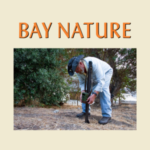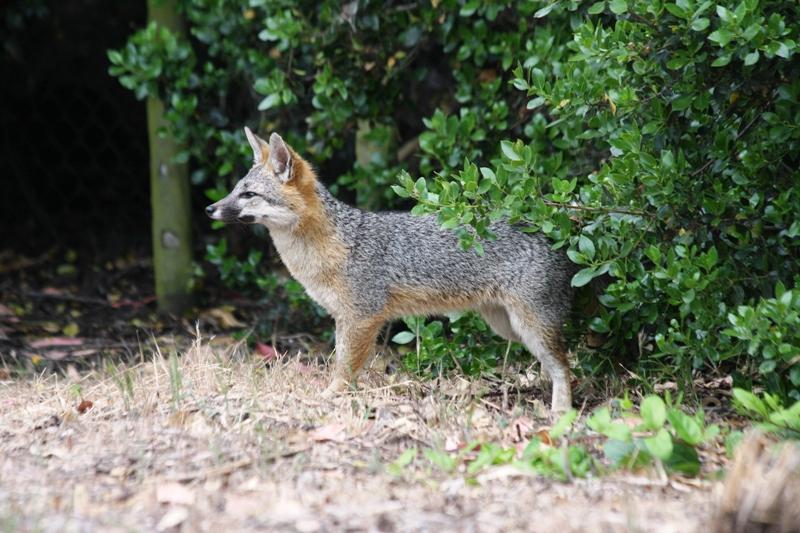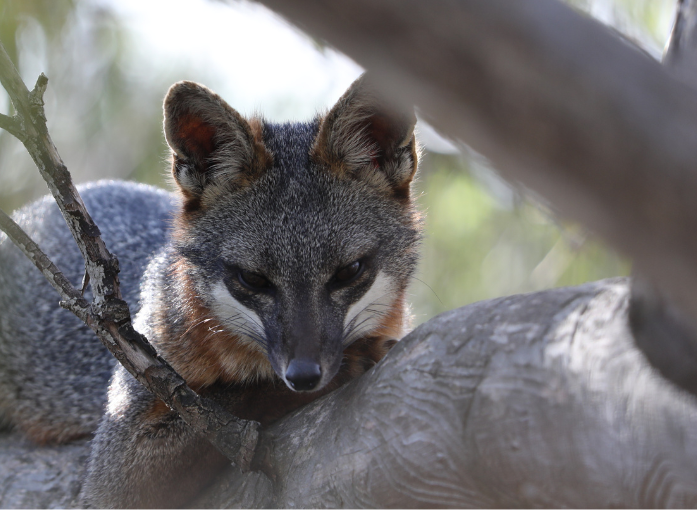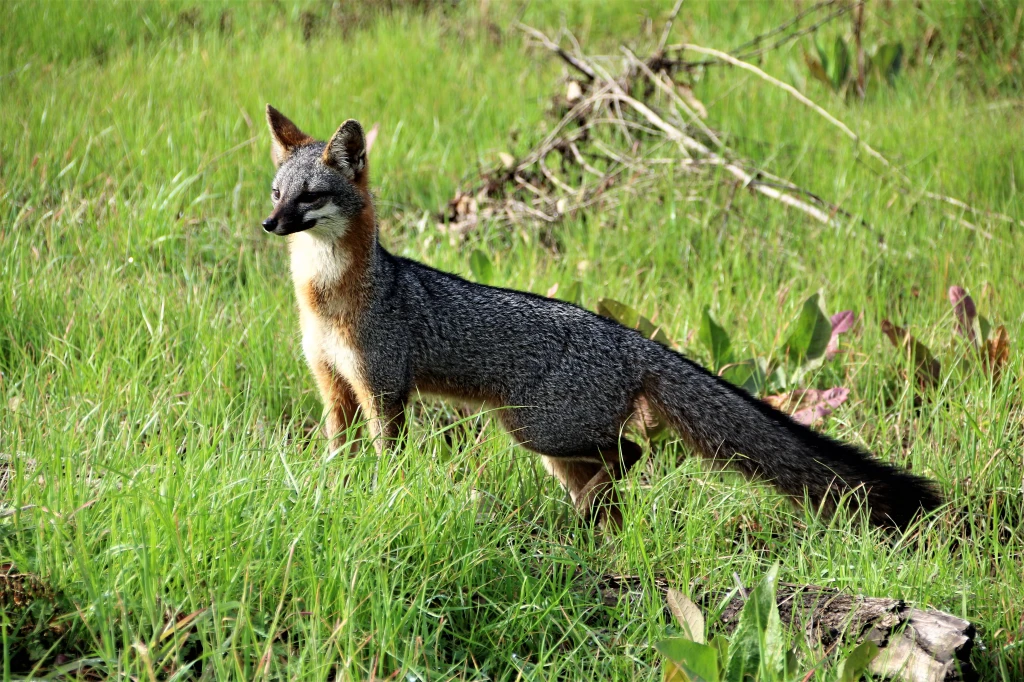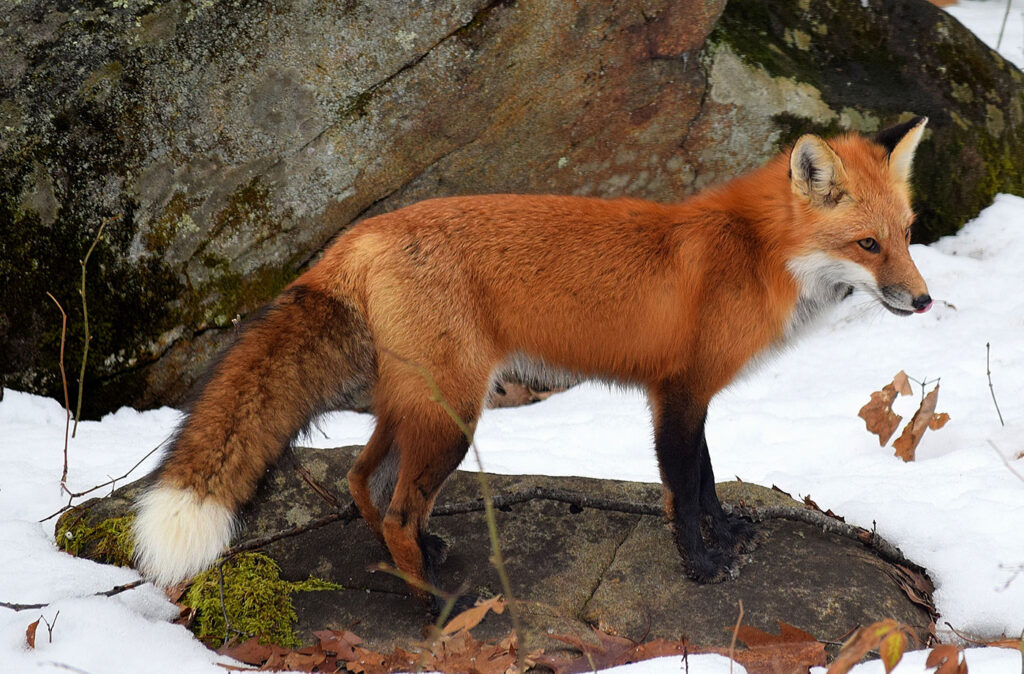by William C. Leikam
President, CEO & Co-founder, Urban Wildlife Research Project
What I’ve Learned About Gray Fox Behavior
Part 1
Over these past fourteen years of studying the behavior of the gray fox (Urocyon cinereoargenteus townsendi) I have learned a great deal but when I first began this journey, I knew nothing, and I do mean nothing, about these foxes. I knew very little about any of the wild critters living in the Palo Alto Baylands Nature Preserve or elsewhere. When I saw my first gray fox sitting beside the road in what is now called Fox Hollow, the only thing I knew was that it was probably a fox. And that was it. So, here’s Part 1; three things I learned about them. This is only the beginning and I’d like to have feed back from my readers as to whether this kind of item interests you.
Fox Kiss
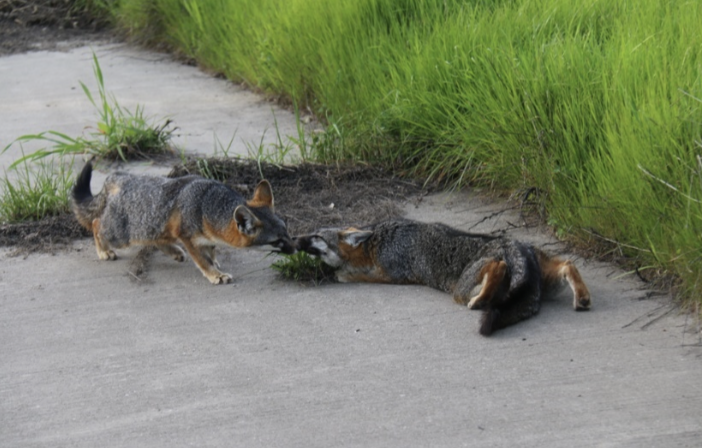
As I began observing the gray foxes on a regular basis, I saw what one might call a flurry of behaviors that gradually took on meaning. One such behavior was what I came to call the Fox-kiss. (I remember taking the photo here.) It is a complex of behaviors and the fox-kiss is playing an important role. The gray fox on the left is the female alpha of the region named Dark Eyes, and the fox on the right is a yearling named Big Guy. He is in a deeply submissive posture. Not only is he recognizing her as his superior but she is returning his greeting with a kiss, and also tail swishing. Dark Eyes is happy to meet up with Big Guy most likely because he is actively showing her proper respect.
Tale Swishing
Almost always at the same time that a pup is giving an adult a fox-kiss, their long, bushy tail swishes from side-to-side in broad sweeping arcs. This is not the same motion as a dog wagging its tail, and yet the fox swishing its tail and the dog wagging its tail are both communicating the same feeling: Happiness. So, if we put the two together, we have a gray fox that rightly pays its respects to the senior adult, and she lets him know that he’s welcome, has done the proper gray fox cultural standard by happily swishing her tail.
Tale Held in an Inverted U
When I first recognized this shape in a tail, I knew that it must mean something, but I had no idea what it meant. One evening out on the Adobe Loop Trail Brownie and Helper were near the old observation platform when I came along. They knew me and so they did not run. About 75 feet off along the road it split: One part going straight ahead and uphill, while the other part made a sharp right. On that corner and to the left going uphill, lay the territorial border that Brownie and his mate Helper claimed.
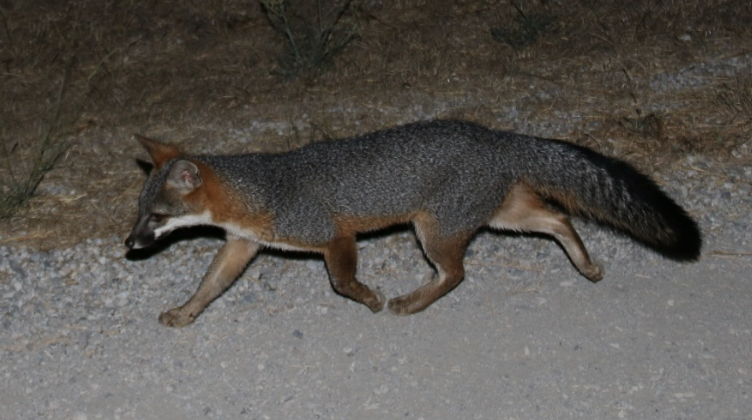
Off to our left and right at the border between Brownie’s territory and that of other foxes, the young gray fox Tense came around the bend and walked toward us. Brownie saw her coming and immediately his tail went up in that inverted U shape, he danced on his “tip-toes” for a moment – that “tip-toe” dance was particular to Brownie and no other gray fox that I ever knew — and then he dashed off toward Tense who by that time had seen him and she ran back to the territorial border down the road. Before Brownie could get to the bend in the road, I yelled, “No, no Brownie!” That little fox stopped. He looked back at me. The expression on his face and just the way he held himself, clearly sent me his message, “What do you mean, no? She trespassed.” Brownie knew that Tense had fled back to her own territory, so Brownie came back to the observation platform, his tail down in a normal flat, low position and he joined up with Helper who sat about 10 feet behind me watching the events unfold. And so, the tail hiked like that means, “I’m up for a fight, so don’t get in my way.”
Grey Fox General Health
Gray fox Big Eyes and Laimos died. There are no gray foxes in the Palo Alto Baylands Nature Preserve.
Gray Fox, Baylands Goals
Within the permit that allows the Urban Wildlife Research Project to conduct its study of the behavior of the gray fox at the Palo Alto Baylands Nature Preserve, the objectives covered are:
- Monitoring of urban gray fox Denning sites in Palo Alto Baylands.
This is being accomplished during the period when the gray foxes use a den site. It is one of the prime locations for gathering most of the behavioral data of the litter and for adults alike.
- Assessment of status and population trends of Baylands urban gray foxes.
Since January 2019 a pair of resident gray foxes have claimed territory at the Palo Alto Baylands Nature Preserve.
- Identification of habitat features that promote the presence of urban gray foxes.
The Urban Wildlife Research Project is working on a project to remove the concrete from Matadero Creek that will create linkages and corridors between the Santa Cruz Mountain Range and the Palo Alto baylands..
- Assessment of reproductive success and identification of factors that promote successful reproduction.
Open the pinch-point along Matadero Creek by developing thickets that link one area to another, instead of the present island-like habitat.
- Identification and assessment of possible dispersal travel routes.
Dispersal routes move between the Palo Alto Baylands Nature Preserve and the Shoreline region over in Mountain View. In a north-westerly direction the dispersal corridors run just behind the homes bordering the marshlands.
What's Happening at UWRP?
Be on the lookout for Bill being booked to give another talk over at Meta (Facebook). We’re working on it.
If you or your organization would like to have Bill aka the Fox Guy present one of his four PowerPoint presentations:
1. A Year with the Urban Gray Fox
2. Human Development, Sixth Mass Extinction & Gray Foxes
3. Gray Fox Cognition – What & How Gray Foxes Perceive
4. Corridors & Connections – Sustaining the Health of Our Wildlife
Contact us here https://urbanwildliferesearchproject.org/contact/ and let us know.
Videos and Documentaries

My journey to the University of Zurich, Switzerland, Triggered By Motion

Bill’s book The Road to Fox Hollow can be purchased directly from Bill for a mere $20.00. Just email him through the Contact form on the Urban Wildlife Research Project’s website, leave your email address and he will get back to you. Or you can contact the publisher Di Angelo Publications .
A video documentary about Bill’s work with the foxes and produced at Stanford University by Syler Peralta-Ramos.
What happens when an opossum and a red fox meet in the night?
In contrast to two other raccoon discipline videos, this one is rather mild.
Gray Fox Playfulness “Hugging” Behaviors.
See the violence of Discipline Raccoon Style.
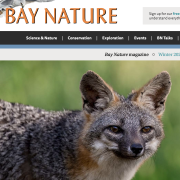
“How to be a Fox” The article about Bill and his ethological approach to his study of the gray fox is online here. Many are calling this a major article in the wildlife press.
Be Sure to check out our YouTube Channel for some incredible wildlife videos.





